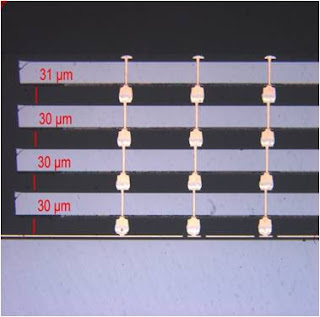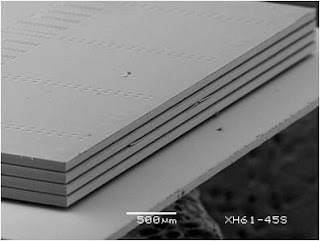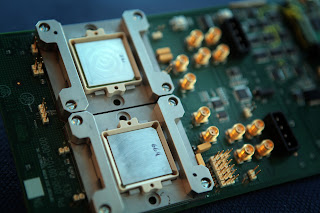Multi-Core Goes Mainstream, Computing Pushed to Extremes
Multi-Core Goes Mainstream, Computing Pushed to Extremes
The Future Accelerated: Multi-Core Goes Mainstream, Computing Pushed to Extremes
NEWS HIGHLIGHTS
- New "Near Threshold Voltage Processor" from Intel Labs challenges the computing system status quo with an experimental Pentium®-class Intel® architecture CPU delivering five times the energy efficiency and the ability to run off a solar cell the size of a postage stamp.
- Intel Labs released a "Parallel JS" engine to the open source community, adding data-parallel capabilities to JavaScript™ to speed up browser-based services such as computer vision, cryptography, and 3-D games by up to 8-fold.
- Intel Labs unveiled the Hybrid Memory Cube with 7-times better energy efficiency than today's DDR3 memory along with the highest data rates ever seen in a single DRAM device.
- Intel CTO Justin Rattner highlighted the accelerating impact of multi- and many-core computing, expanding beyond HPC with developers solving a wide range of everyday computing problems on both clients and servers.
INTEL DEVELOPER FORUM, San Francisco, Sept. 15, 2011 – Citing the impact of multi- and many-core computing hitting the mainstream and new developments in extreme scale computing as examples, Justin Rattner, Intel's chief technology officer, told an Intel Developer Forum audience that the future of computing is being accelerated.
"Since 2006 Intel and the IA developer community have worked in partnership to realize the potential of multi- and many-core computing, with accelerating impact beyond high-performance computing to solving a wide range of real-world computing problems on clients and servers," Rattner said during his Day 3 keynote in San Francisco. "What we have demonstrated today only scratches the surface of what will be possible with many-core and extreme scale computing systems in the future."
Computing to the Extreme
Intel continues to push tech beyond today's limits, looking for the next big leaps that take computing to the next levels of performance with much less power consumption than is possible today. As an example, Rattner demonstrated a Near-Threshold Voltage Processor using novel, ultra-low voltage circuits that dramatically reduce energy consumption by operating close to threshold, or turn-on voltage, of the transistors. This concept CPU runs fast when needed but drops power to below 10 milliwatts when its workload is light – low enough to keep running while powered only by a solar cell the size of a postage stamp. While the research chip will not become a product itself, the results of this research could lead to the integration of scalable near-threshold voltage circuits across a wide range of future products, reducing power consumption by 5-fold or more and extending always-on capability to a wider range of computing devices. Technologies such as this will further Intel Labs' goal to reduce energy consumption per computation by 100- to1000-fold for applications ranging from massive data processing at one end of the spectrum to terascale-in-a-pocket at the other.
The Hybrid Memory Cube, a concept DRAM developed by Micron* in collaboration with Intel, demonstrates a new approach to memory design delivering a 7-fold improvement in energy-efficiency over today's DDR3. Hybrid Memory Cube uses a stacked memory chip configuration, forming a compact "cube," and uses a new, highly efficient memory interface which sets the bar for energy consumed per bit transferred while supporting data rates of one trillion bits per second. This research could lead to dramatic improvements in servers optimized for cloud computing as well as ultrabooks, televisions, tablets and smartphones
Multicore's Many Uses
Multi-core, the practice of building more than one processing engine into a single chip, has become the accepted method to increase performance while keeping power consumption low. While many-core is more of a design perspective, rather than incrementally adding cores in a traditional approach, it's reinventing chip design based on the assumption that high core counts is the new norm.
Rattner highlighted the progress multi-core computing has seen since he introduced Intel's first dual-core processor at IDF 5 years ago. Today Intel's multi- and many-core processors are hosting a myriad of important applications across a wide range of industry sectors, including some surprising new uses in the rapidly advancing world of high-core-count computing.
Rattner described some of the latest applications of this technology along with the software tools and programming techniques that are enabling developers to harness the power of multi- and many-core computing in several key areas, including:
- Faster Web Apps: Extending JavaScript™ with data-parallel programming features, using a just-released experimental Parallel JS open-source engine from Intel Labs, to enable a new class of browser-based apps in domains such as photo and video editing, physics simulation, and 3-D gaming for desktop and mobile personal computers, including Ultrabooks™.
- More Responsive Cloud Services: Best-in-class increases in queries per second for Memcached applications using the multi-core capabilities of Intel's 2nd Generation Intel® Core™ microprocessor to enable the world's largest Internet sites to improve their Web app responsiveness and minimize user wait times for critical data.
- Improved PC Client Security: Parallel cryptographic and facial recognition services to improve security on Ultrabooks and traditional notebook and desktop personal computers by utilizing all of the IA and graphics cores on 2nd Generation Intel Core microprocessors in a heterogeneous fashion.
- Lower Cost Wireless Infrastructure: Collaborative research with China Mobile to replace the custom and costly base-station hardware used on cell towers today with a fully programmable and far more cost-effective, software-based PC alternative.
- Really Big Science: Unlocking the mysteries of the universe by utilizing clusters of Intel multi-core processors at CERN* to greatly improve their high-energy physics app performance and to quickly port their code to Intel's upcoming Many Integrated Core (MIC) architecture product family.
Information taken from http://newsroom.intel.com/community/intel_newsroom/blog/2011/09/15/the-future-accelerated-multi-core-goes-mainstream-computing-pushed-to-extremes?cid=rss-90004-c1-269953





 Previous Entries
Previous Entries






0 comments for Multi-Core Goes Mainstream, Computing Pushed to Extremes
Leave a reply